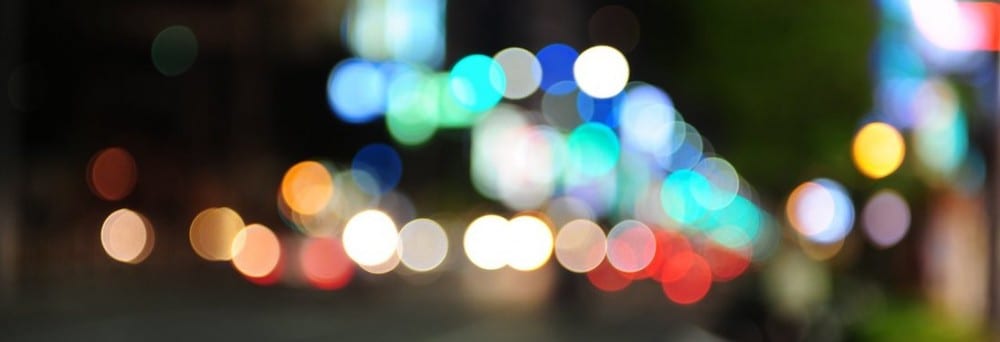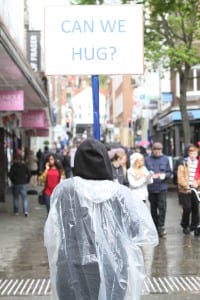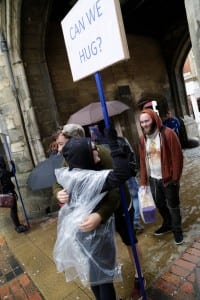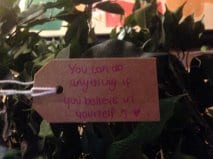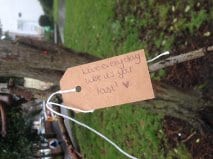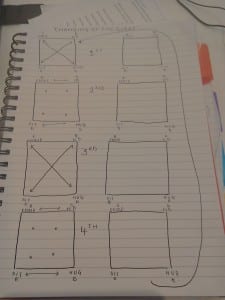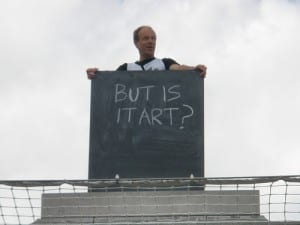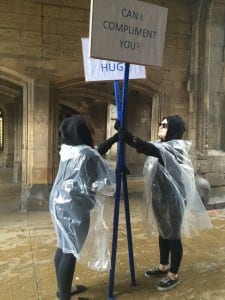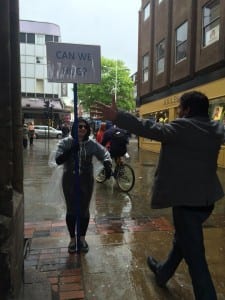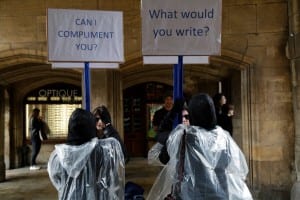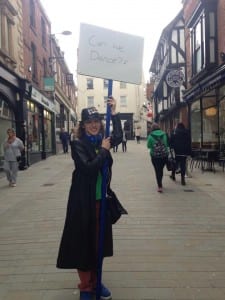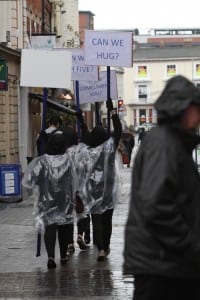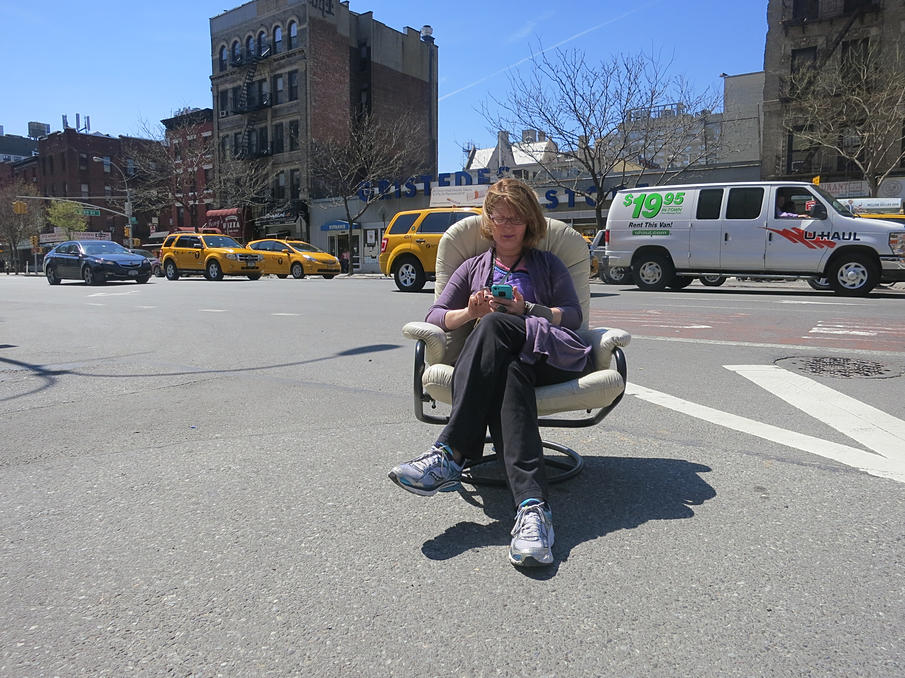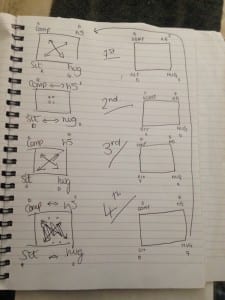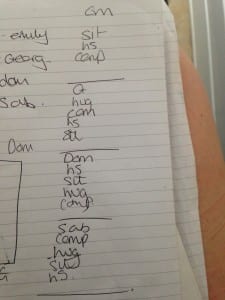Framing Statement
Site-Specific Performance is a term that is hard to completely define, however it is mainly referred to as performance that is only relevant to a specific ‘site’ or ‘place’. If this performance was to be performed in any other location it would become irrelevant, it is also about removing performance from the standard auditorium space to surrounding areas outside and further afield. “The conventions and techniques of the auditorium may be inappropriate or inadequate for ‘site’.” (Pearson, 2010) Our group were given the choice of using either the Lincoln High Street or The Brayford Waterfront as our site. We chose the High Street and began to focus on consumerism and the public’s everyday routines. We aimed to liberate people from consumerism and their everyday routines through human interaction in order to create a sense of happiness and relief. We created four A2 signs that were secured onto large poles to enable them to be seen from a distance they read; ‘Can We Hug?’ ‘Can We High-Five?’ ‘Can I Compliment you?’ and ‘What would you write?’ we felt these phrases would encourage a large amount of interaction and disrupt the flow of peoples routines.
“The most important aspect was approaching strangers on the street and the interaction between us”
(Wearing, 1999)
Our durational piece took place on the 7th of May, and was supposed to last just over 4 hours however on the day due to poor weather we finished early but still managed to hold each sign for 30 minutes. We started at 11am and finished at 1.30pm, in order to allow each member to have each sign at some point we included the ‘Changing of the guard’ routine. We took inspiration for this by watching the Queens Guard procedure at Buckingham Palace. We wore matching outfits of Black hoodies, sunglasses, white tops, black leggings and transparent rain ponchos, this paired with the guard routine made the piece uniformed, and allowed the audience members to recognise the performance element of the piece more obviously. Also by including this routine it would continue to obstruct everyday life as we will be placing this uniform ritual in the middle of the high street which is not something to occur in everyday life, thus allowing us to keep liberating society from their social norms. Due to this uniformed routine being added and the fact that we aim to break routine in consumerism we came up with title of our piece; A March against Consumerism.
We took inspiration for our piece, from practitioners such as; Gillian Wearing, Tim Etchell and Crabman and Signpost. The main source of inspiration for our piece came from The Situationists International and Guy Debord’s ‘The Society of The Spectacle’. “The situationist analysis of contemporary capitalist society was simple and effective. Its express purpose was to transform this society, and it remain.” (Plant, 1992) We aimed to create something that had the ability to transform society even if just for a moment, we planned to do so through human interaction and to put a break in consumerism. We also felt that analogue methods suited our social aspect more so liberated ourselves from the use of pervasive media.
Analysis of Process
Before we chose our group for the final performance we were given a task to complete in pairs, we had to read ‘25 Instructions to Performance in Cities’ from Teaching Performance Studies and choose a task to perform. Georgia and I decided to create a situation for a mass audience of spectators by leaving messages of enchantment and friendliness on trees throughout the city. We wrote different messages on luggage tags and tied them to different trees, some on the Waterfront and some on the high street; we got more of a response when placing them on the high street and had a lot of children asking us what we were doing. We felt this task would create a sense of happiness within the city and we liked the idea of giving someone a ‘gift’ even if it was just kind words that would make them smile.
Following this task we looked at Tim Etchell’s ‘8 Fragments of Theatre and The City’ and mainly focused on the observation/coincidence fragment where Etchell describes the way people ignore each other as they walk past and states that the most extreme form of this as the escalator “where we pass each other as if objects on a production line”, “We watch each other, getting closer, and then just when we could speak, or even touch, our eyes drop and the moment passes.” (Etchell, 1999, p.78) After reading this chapter we formed a group of four that we would stay in for our final performance and decided to explore further into the observation fragment by taking our exploration to Lincoln high street. We filmed the high street and wrote a message that describes how we observe each other every day. We took into account all the things Etchell explores in his fragment and included footage on escalators to go with his view of the ‘production line’. We then wanted to challenge the social expectancy in society and reach out to members of the public to see if they would respond and we recorded this footage and our outcomes.
We realised that the social interaction theme was present in both tasks we had completed, and also the thought of giving ‘gifts’. We spoke about how a man on the street was handing out flyers and people were just ignoring him because of what he was handing out, we discussed the notion to distribute gifts that aren’t as easy to ignore such as verbal or physical gifts rather than objects. We then thought about how to display these gifts to the audience members, keeping it simple but effective we came up with the idea to use large speech bubbles with phrases on that invited audience members to interact with us. We also then decided we wanted to perform on the high street as this is where we were getting the most responses.
We were taken with the idea of using social interaction through giant speech bubbles but that’s all we had so we began to look at different practices to gain inspiration. In class we watched ‘Super Night Shot’ by the Gob Squad, although their ideas weren’t exactly the same as ours we enjoyed the playfulness of the performance, the Gob Squad’s website describes it as “the public become co-stars in a movie that celebrates unplanned meetings with strangers and delights in the randomness of urban existence.” (Gob Squad, 2015) We wanted to replicate the playfulness by interacting with the audience through a series of questions and interactions. We also favoured the idea of synchronisation, in their piece they used synchronised watches to perform different sequences at the same time. We also saw this in Ligna’s Radio Ballet in Leipzig Main Station, where listening to audio pieces everyone partook in synchronised movement, this inspired us to include some form of synchronisation in our piece and to make it a durational piece lasting 4 hours.
(Gob Squad, 2008)
(Radiodispersion 2008)
We looked at Crabman and Signpost’s ‘A Sardine Street Box of Tricks’ they recommended using the Situationists theory of ‘drifting’ or ‘deriving’ “aimless wanders (walks without destinations); in which walkers allow themselves to be drawn along by atmospheres and ambience.” (Crabman and Signpost, 2011) It is also a way of studying your site in great depth looking for and noticing every nook and cranny and to find “happy accidents, coincidences, incidents and discoveries.” (Crabman and Signpost, 2011) I walked from the bottom of the high street to the top of steep hill and really took into account everything I was passing; I took photos of things I had never noticed before and became fully absorbed in our site. The discovery of a ‘Roman Portico’ hidden on the side of an archaic building made me feel as if I was living in a historical ‘Lindum Colonia’ and it began to really excite me and make me want to learn more about the discoveries of archaic architecture or artefacts around Lincoln.
I remember feeling separated from everyone around me as I was walking without purpose unlike them; the consumers, the workers, the tourists, I was just taking in my surroundings and becoming one with the site. Once we had all completed the drifting process we began to look at how the city moves, we watched different people carry out their everyday routines and took note of the different times that these things happened; we felt that these timings could be replicated in a synchronised routine.
Once we had finalised the basic outline of our piece, we began to look at the production of the speech bubbles and how we were going to make them. After much consideration we came to the conclusion that to be able to fit our budget instead of speech bubbles we would be making A2 placards that would be fixed to 3 foot poles to ensure visibility from a distance. We originally came up with the idea to print quotes on one side of the signs to do with liberation; after reading about the Situationists in Sardine Street we looked at Debord’s ‘Society of The Spectacle’ and other Situationist texts to inspire us for quotes.
“There can be no freedom apart from activity, and within the spectacle all activity is banned a corollary of the fact that all real activity has been forcibly channelled into a global construction of the spectacle. So what is referred to as “liberation from work,” that is, increased leisure time, is a liberation neither within labour itself nor from the world labour has brought into being.” (Debord, 1995, p.9)
We felt this quote was appropriate for our performance because it discussed the fact that all ‘real activity’ is banned in the ‘spectacle’ meaning no one is able to behave in a way that is seen as original, instead they act in the way that society expects them to. We aimed to explore this by breaking the consumer conventions of society on the high street and disrupt people’s social norms. This then sparked us to look further into the Situationist International; we were inspired to make our piece in a way that could allow it to somewhat transform and reform society by liberating it from its normal expectations. After much debate and as the piece developed we realised there was no need to display a quote on the sign, as the act of interaction itself conveyed liberation by releasing people from their routines. We finally decided on using the phrases ‘Can We Hug?’ ‘Can We High-Five?’ and ‘Can I Compliment You?’ we couldn’t decide on a fourth sign at first so decided to try out two ‘Can I Help You?’ and ‘Can I Lend an Ear?.’
We took to the high street to experiment and test out our signs; the latter two signs barely got a response, in contrast to the other three which were highly received, in fact when holding the “Can I compliment you sign” I personally had a few great reactions from members of the public, one man came up to me and asked what I was doing because he had been watching us with the signs, I explained and he replied “I don’t normally go out of my way to talk to people, but you really interested me and made me want to talk to someone new” he was impressed and then left smiling. Then following that one Woman gave me a hug and told me I had made her day then complimented me and left also smiling. This was exactly what we aimed to do, something the public weren’t used to but that made their day. “[situationist] movement stands in a less distinct line of pleasure-seeking, libertarianism, popular resistance and autonomous struggle and its revolutionary stance owes a great deal to this diffuse tradition of unorthodox rebellion.” (Plant, 1992, P.1) By creating the interaction in society we feel as though we are part of the situationist movement mainly partaking in pleasure-seeking and libertarianism as we are liberating society from social norms and also just trying to make people feel happier.
Before finding our final sign we went back to the synchronization idea and decided it had to be something that allowed us to swap signs so that we all had an equal amount of time with each sign. We took inspiration from the Queens Guard at Buckingham Palace and came up with a ‘Changing of the guard’ routine. By creating and adding this routine to the performance we will continue to obstruct everyday life by placing a uniform ritual in the middle of the high street, this is not something to occur in everyday life, thus we will be liberating society from their social norms. A known situationist slogan used in the May 1968 uprisings was “La Beaute est dans la rue” or “Beauty is in the street” by making a ritual routine that occurs every 30 minutes we felt we would be representing this situationist slogan and putting some beauty in the street. To then carry on this ritual and theme when finishing our piece we will march out of our site never breaking our ‘character’.
We were then still left with the underlying problem of the fourth sign, we came across this quote “Revolution is not ‘showing’ life to people, but bringing them to life. A revolutionary organization must always remember to that its objective is not getting its adherents to listen to convincing talks by expert leaders, but getting them to speak for themselves, in order to achieve, or at least strive toward, an equal degree of participation.” (Guy Debord, 1961) We felt that this quote summed up our piece as a whole so in order to appease this we decided to make our last sign encourage that equal degree of participation by making the audience member swap places with us for a while and hold the sign. We still weren’t entirely sure how to gain this equal degree so we looked at Gillian Wearing’s ‘Signs that say what you want them to say and not signs that say what someone else wants you to say’ her method was just to get people to say anything that was on their mind “I think people just felt, ‘I can say something’, and that it was a nice idea that they’d been approached.”(Wearing, 1999) Keeping this in mind we looked at Anthony Gormley’s ‘One and other’ performed on the fourth plinth in Trafalgar Square; where he used members of the public at different times for an hour each as his artwork. “I have no expectations. I would be absolutely happy if somebody got up there with an umbrella and just stood still for an hour. The idea is that this will be a portrait of Britain made out of 2,400 hours of 2,400 people’s lives.” (Sooke, 2009) We decided to something similar with our final sign to encourage the audience to write down what they would be comfortable holding up to the public for social interaction. The sign was going to be a large whiteboard with ‘What would you write?..’ written at the top and on the flip side of the sign, we will be handing over a whiteboard marker allowing the audience member to write on the board and then to continue this participation we will be asking them to hold the sign whilst we take a picture of them holding the sign.
Once we had all of our signs, we came up with the order in which we were going to stand; ‘Can I Compliment You?’ at the bottom of the high street, ‘Can We High-Five?’ further along, then ‘Can We Hug?’ and finally at the top ‘What would you write?’. This order was created to show the degree of separation decreasing as you got further along the high street, starting with a compliment that can be shouted to the audience member from the opposite side of the street, ending with what would you write where the audience member becomes the piece. So we would swap signs but they would always stay in the same place with regards to the high street. We had finalised our piece, so decided to do a dress rehearsal on the University Campus, we gained good responses from the public which made us happy with our final decisions and ready for the final performance.
Evaluation of Performance
On the 7th of May we took once more to the Lincoln High Street, at 11am we marched to the Stone bow in the centre of the high street then marched out to our separate places. When we first began the weather was sunny, this affected the piece in a good way as people tended to be happier to participate when the weather was nice. I began with ‘Can We High-Five?’ and worked my way through the signs getting a lot of responses. However, the weather changed after an hour and began to rain heavily, people became less responsive. Apart from some people who once had responded to our signs said they felt sorry for us standing in the rain so participated. When people asked what we were doing we replied; “The aim of the high street nowadays is to get people to spend money, we want to disrupt this through human interaction and break people’s everyday routines even if just for a fleeting moment.” Once explaining this people seemed extremely happy and we were often told that people really liked what we were doing and that it was a nice idea. We began to realise as the day went on that it was taking the form of a happening “The participatory and interactive nature of a ‘happening’ ensures that each one is a totally unique theatrical/performance experience that cannot be recreated.” (TINATC, 2014) This was true to our performance as even if you recreate the performance you can’t recreate the responses you gain, so no matter how many times we held our signs on the high street we would always get different responses. Allan Kaprow believed that happenings were very playful activities that involved audience members participating for the sake of playing; this is also true to our performance as we wanted to keep it playful and managed to do so successfully on performance day.
The changing of the guard routine worked well in allowing us to swap the signs, and the matching costume coincided to make us look uniformed. However, due to the heat in the first hour, Sabrina felt ill and had to remove her poncho, this did not greatly affect the piece as we were still able to carry out the routine looking uniformed by keeping ‘in character’ whilst marching and swapping the signs over. Due to the weather change we cut our piece at 2 hours instead of 4, this did not affect the piece as we still all managed to hold each sign for 30 minutes and gain a lot of varied responses from audience members. Apart from weather issues, the piece was a success and we completed our desired aim to disrupt consumer’s routines for a moment and brighten their day. We successfully liberated society from its social norms for a moment, and people seemed to enjoy it. I feel as though my understanding of site specific performance has greatly increased throughout this module and with reading different theories and practices I helped to create a successful performance.
Bibliography
Apted, M., Ferguson, R. and De Salvo, D. (1999) Gillian Wearing. London: Phaidon Press.
Crow, P. (2015) Site Specific Performance Photos. [online photo] Available from: https://www.flickr.com/photos/61839232@N02/16804364814/in/album-72157652062387628/
Crow, P. (2015) Site Specific Performance Photos. [online photo] Available from: https://www.flickr.com/photos/61839232@N02/16804384074/in/album-72157652062387628/
Crow, P. (2015) Site Specific Performance Photos. [online photo] Available from:https://www.flickr.com/photos/61839232@N02/16804358994/in/album-72157652062387628/
Crow, P. (2015) Site Specific Performance Photos. [online photo] Available from:https://www.flickr.com/photos/61839232@N02/16806636403/in/album-72157652062387628/
Debord, G. (1961) Pour un jugement révolutionnaire de l’art. Translated from French by Ken Knabb. The Bureau of Public Secrets.
Debord, G. (1995) The Society of the Spectacle. Translated from French by Donald Nicholson-Smith. New York: Zone Books.
Etchell, T. (1999) Certain Fragments. London: Routledge.
Gob Squad. (2015) Super Night Shot Overview. [Online] Available from: http://www.gobsquad.com/projects/super-night-shot [Accessed on: 12/05/15]
Gob Squad. (2008) Super Night Shot (2004) [online video] Available from https://www.youtube.com/watch?v=-anpj9LS4vg [Accessed on 14/05/2015]
Jones, J (2013) Will digital age kill of art? The Guardian. [Online photo] Available from: http://static.guim.co.uk/sysimages/Guardian/About/General/2013/7/2/1372778640203/What-is-Gillian-Wearing—010.jpg [Accessed on: 12/05/2015]
Kaprow, A. (1959) Fluxus and Happenings [online] http://members.chello.nl/j.seegers1/flux_files/kaprow_chronology.html
Lavery, C. (2005) Teaching Performance Studies: 25 Instructions for performance in cities. Studies in Theatre and Performance, 25(3) 229-238.
May, P. (2009) But is it art? [Online photo] Available from http://farm3.static.flickr.com/2550/3697618831_94c2773f80.jpg [Accessed on 13/05/2015]
Pearson, M. (2010) Site Specific Performance. Basingstoke: Palgrave Macmillan.
Persighetti, S., Smith, P. (2011) A Sardine Street Box of Tricks. Plymouth: Blurb Inc.
Plant, S. (1992) The Most Radical Gesture. New York: Routledge.
Radiodispersion (2008) Radio Ballet Leipzig Main Station part 1. [online video] Available from https://www.youtube.com/watch?v=qI3pfa5QNZI [Accessed on 14/05/2015]
Sooke, A. (2009) Antony Gormley’s Fourth Plinth, Trafalgar Square. The Telegraph,26 Feb. [Accessed Online] at: http://www.telegraph.co.uk/culture/4838343/Antony-Gormleys-Fourth-Plinth-Trafalgar-Square.html
This Is Not A Theatre Company. (2014) [Online] http://www.thisisnotatheatrecompany.com/#!happenings/c1gt3
Thompson, D. (2009) Participant in Anthony Gormley’s Fourth Plinth. [Online photo] Available from http://2.bp.blogspot.com/_TWDIyi5pqlc/SlUCHyEH1gI/AAAAAAAAE5Q/kjQBcuLIAOI/s400/Picture+9.png
